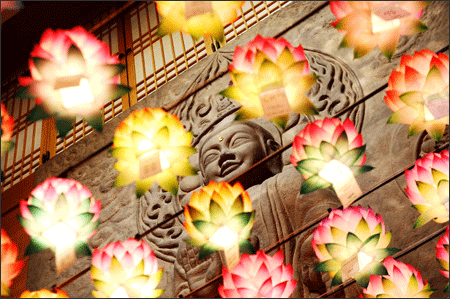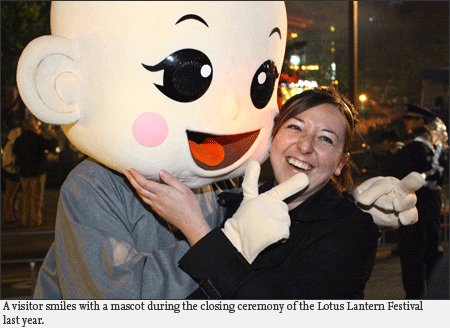
There is a Buddhist saying that goes: “Please attain Buddhism in your next lifetime by lighting a lantern in this life.”
The saying is being realized by many Buddhists this May, as they visit temples scattered around the country to light lotus lanterns and celebrate Buddha’s Birthday.
“It’s hard for me to light lanterns every day, although I would love to. Buddha’s Birthday is one of those days when I just have to put everything aside and light up a colorful lantern for the well-being of my friends and family,” Yoon Myung-sook, a 52-year-old housewife who visited Bongeun Temple in Samseong-dong, said.
Buddha’s Birthday is celebrated annually on the eighth day of the fourth lunar month ― May 21 this year ― and the Jogye Order of Korean Buddhism is gearing up for its annual Lotus Lantern Festival, or the “Yeondeunghoe.”
“Within the Buddhist religion, Buddha’s Birthday is the biggest holiday among other events. We always had lotus lantern events throughout history and it’s a time when you get to learn and appreciate Buddha and his teachings.
It’s a time to stand back and really embrace his lessons,” Ven. Jong Min, deputy director of the Department of General Affairs at the Celebration Committee for Buddha’s Birthday, told The Korea Times.
“It has also become an event where numerous foreigners participate, further bringing Korean Buddhism to an international level,” he said.
Events
The Lotus Lantern Festival has become bigger, with more exciting events and performances visitors can enjoy, including parades, exhibitions and activity booths.
May 14 to 23
Bongeun Temple, located in Samseong-dong, is one of the most famous temples in Seoul. Located in the heart of the city, it offers a tranquil atmosphere amid the busy streets full of cars and numerous skyscrapers. To celebrate Buddha’s Birthday, the temple is holding a special exhibition of traditional lanterns.
Take a break from the hustle and bustle of the day, and enjoy both large and small, colorful lanterns made by devoted Buddhists. Bongeun Temple is located near exit 6 of Samseong Station on subway line 2. For more information, visit www.bongeunsa.org.
Another way to enjoy lanterns is by visiting Cheonggyecheon, or Cheonggye Stream. The narrow stream will be decorated with numerous lanterns, creating a dream-like atmosphere with colorful lights shining brightly in the dark.
Large lanterns will be placed on several platforms in the middle of the stream, perfect to take photos with or simply walk, observe and appreciate lights.
May 15
The Festival’s Eve Celebration will take place in the Insa-dong area, near the Jogye Temple, on May 15. The street near the temple will be lit with colorful lanterns, and exciting stage performances, parades and other interesting events will add to the festivity.
The parades and events will start from 7 p.m. to 9 p.m. Get a quick preview of the festival at the Eve Celebration near Jonggak Station on subway line 1 and Anguk Station on line 3.
May 16
Buddhist Street Festival
The following day will be interesting for both believers and non-believers. The Buddhist Street Festival will take place on the street in front of Jogye Temple.
The whole street will be full of interesting and educational booths set up by Buddhists, the festival committee and also foreigners who wish to share their own unique culture with visitors.
Last year, the street was full of people wishing to participate. Visitors walked freely along the streets, poking their heads into the booths, some staying to learn various activities, including Buddhist art, making lotus lanterns and trying out temple food, while others walked along the some 100 booths to feel the gist of the festival. This year is expected to be similar, yet better.
Some booths will observe religious rituals, giving visitors a moment to take photos and try on costumes themselves to feel the spirit of Buddhism.
Other booths organized by a number of Buddhist countries, such as Tibet, Thailand and Cambodia, will offer their distinctive Buddhist culture they practice in their home countries, from clothes and folk games to food.
Check out the festival guide booklet beforehand, as it could be overwhelming to try out everything.
On the same day, organizers will build a large stage where various traditional performances will take place. Korean folk performers, Lotus Lantern Festival performance groups and International Buddhist communities will put on an eye-catching shows to further escalate the festivity. The street festival and performances will start from noon to 7 p.m.
For those who want to experience a more formal and educational performance, visit Dongguk University Stadium at 4:30 p.m. on the same day for the Buddhist Cheer Rally or “Hwahap Hanmadang.” A traditional Buddhist ritual called the “Beopyusik” will be underway to celebrate Buddha’s birthday, along with the lightings of numerous lanterns.

Lantern Parade
The main event of the festival is the Lantern Parade, where more than 100,000 lanterns will create an ocean of lights.
“In China, there are parades where designated people hold large lanterns, walk around and spectators enjoy the parade. The Korean Lotus Lantern Festival is different because it allows everybody to enjoy.
The participants make their own small lanterns and are more than welcome to walk along the parade,” said Park Sang-hee, team leader of the Celebration Committee for Buddha’s Birthday.
In order to create prettier and more durable lanterns, the festival committee held seminars and worked with various materials over the past year.
According to Park, the lanterns in the past were simpler in shape, but they tend to get more colorful and fancier year after year.
Larger and fancier lanterns depicting Buddha, lotus flowers and various animals will also be on floats along with the small ones.
The parade will start travel Dongdaemun to Jogye Temple along Jongno Street from 7 p.m. to 9:30 p.m.
From 9:30 p.m. to 11 p.m., visitors, festival organizers and performers can all get together to enjoy the “Hoehyang Hanmadang,” or the Closing Ceremony, at Jonggak Intersection.
Dance, sing and take photos with friends, families and other visitors as the Lotus Lantern Festival finally comes to an end, promising a much better year next year.
English, Chinese and Japanese interpreters will be present throughout the event. For more information, visit www.llf.or.kr or call (02) 2011-1744.
The lotus lantern custom goes a long way back in history. For Korea, the oldest records regarding the lanterns are from the Silla Kingdom (B.C. 57-935 A.D.). The lotus blossom represents purity and Buddha, and so it has been depicted in many paintings, decorations and sculptures over the years.
Unlike other flowers, the lotus normally blossom in dirty swamps and lakes. No matter how dirty the water and surroundings may be, the blossom remains clean. This feature of the flower allowed Buddhists to believe that Buddha himself was like a lotus.
Author : Han Sang-hee
Source : http://www.koreatimes.co.kr




